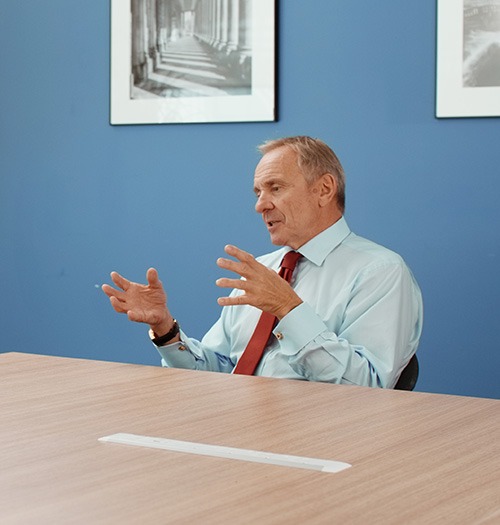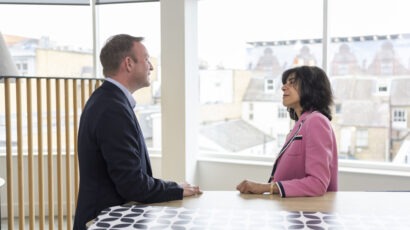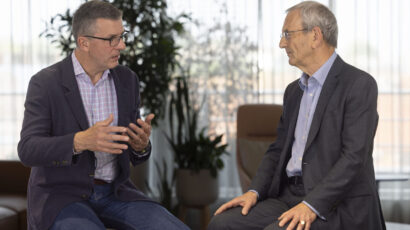
From one Chair to another: the continuum of transition
“When I first joined the board in 2007, we were one of the largest carbon emitters in in the UK,” says Richard Gillingwater, former SSE Chair (from 2015-2021), and Chapter Zero Supporting Chair. “Our carbon inventory was around 25m tonnes of greenhouse gases – all of it from generating electricity from coal and gas. There was a seminal board meeting not long after I joined, where – although the climate science was not very refined at the time – we set out the key role SSE had to play in the transition.” At this time, the board was digesting the implications of the Climate Change Act 2008.
Both the board and the executive leadership recognised that decarbonising electricity was inevitable, and the first carbon reduction targets were set. “That sparked several significant firsts, with the pivotal acquisition of Airtricity in 2008 coming up front, and with it came a hugely important pipeline of renewables projects,” says Gillingwater.
Seagreen, Scotland's largest offshore wind farm was also started, built and commissioned during Gillingwater’s tenure as Chair. It has the deepest fixed bottom foundations of any wind farm in the world and was one of the largest construction projects ever undertaken in Scotland.
He says: “This pipeline allowed for the displacement of electricity-generation from coal, with SSE’s two very large coal generators closing in 2015 and 2020. By the time I left the Board, SSE’s carbon emissions were reduced from a high of 25m tonnes to under 10m tonnes.”

In 2021, the baton – as Chair – passed to Sir John Manzoni, Chapter Zero member. Under his chairmanship, Manzoni amplified SSE’s decarbonisation strategy and invested, amongst other things, in the Dogger Bank development.
While the hard yards of decarbonisation had been implemented throughout the 2010s, by the time Manzoni joined the board as Chair, climate science had developed, the importance of the concept of ‘net zero’ had gained traction and the UK Government had enshrined net zero in UK law. The whole country had stepped up its vocalisation of the issues.
What is more, the scientific and technical credibility of climate targets and climate plans became key to stakeholders and shareholders alike. Targets had to be grounded in science, and ensuring SSE had ongoing credibility was a priority for the board. The formalisation of this work is demonstrated in SSE’s ‘Net Zero Transition Plan’, the external assurance of the greenhouse gas inventory and enhanced governance. Regular ‘say on climate’ resolutions at the AGM (from 2021) ensured shareholders and management remain aligned.
“SSE’s carbon emissions are about 5-6m tonnes now,” says Manzoni. “While the decline was probably linear at the beginning, it’s getting less linear now, but it’s still incredible that we have done this. As we look forward, it's getting harder.”
Nevertheless, decarbonisation is well and truly embedded in SSE’s strategy. “The science and the impacts are irrefutable,” says Manzoni. “SSE has a strategy that is completely aligned with solving these problems. Every pound we spend is aligned with solving them – we are one of the central players in this country to help with this. The electricity system needs to transition first so that everybody else can transition. And that's what's so important about the role SSE plays.” In effect, SSE and similar companies are helping to decarbonise the UK economy simultaneous with decarbonising their own businesses.
Gillingwater adds: “The whole issue of climate change is the most pressing issue we face as humanity; and the impact of it, physically and economically, is profound. If you think about where the actors are, the institutions that create the problem, most of that is happening in the corporate world, because the corporate world is the major generator of economic activity.” To put this into perspective, the UK’s National Health Service generates about 3-4% of carbon emissions in the UK; the electricity industry generates about 15-15.5%.
Fundamental conversations with government
“What's interesting now is that government policy hasn’t kept up around renewable energy generation,” says Manzoni. “We at SSE can do energy generation, renewable generation, networks or we can do flexible generation. Being able to perform this mix is important right now because the policy environment, the regulatory environment and the structure of government policies are insufficient to allow a fully green transition in all aspects.”
And, Manzoni points out, even more investment in the networks is required because they are critical to the achievement of net zero. He sees SSE as being a green champion and says that, increasingly, SSE’s job is to be the interface between the ambition to achieve net zero generally and shareholder investment. The company is also intrinsic to conversations with the UK Government about how it can attract private capital to help achieve net zero while keeping energy affordable for the consumer.
Gillingwater adds: “If I track back to that famous board meeting in 2008, one of the things that became clear was the importance of holding onto a really long-term vision about the role that SSE could play in this very big question of decarbonising the economy, as well as having some shorter-term targets.” He acknowledges that there have been some setbacks because of the vicissitudes of government policies (which have had the consequence of backburnering some potentially ground-breaking decarbonisation projects) but the long-term view has been vital.
“During the period I was Chair, and during this subsequent period (during Manzoni’s tenure as Chair), SSE has had one CEO for 12 years. During that time, we have had 23 energy ministers and secretaries of state,” says Gillingwater.
Lessons learned
While people change, the vision cannot falter if the UK is to decarbonise. Successfully passing the baton is vital to this ambition. Gillingwater says: “You have to see obstacles as bumps in the road rather than insurmountable barriers.”
For example, in 2013 when policy around wind power changed, SSE paused some of its offshore wind plans but it kept its options open to restart those plans when practical to do so. The same happened in 2024 around carbon capture.
The role of boards and their individual members are vital to long-termism. Let’s not forget than many board members work across a portfolio of companies and bring both their experience and influence to bear across all those boards.
Gillingwater puts it like this: “The role that I've played on the various boards that I've been on has been to encourage very strong approaches to how those companies transition to reduce carbon emissions to net zero – and within an appropriate timescale.”
It’s not only a case of passing the baton from one Chair to the next; it’s also a case of having influence from one board to another, especially through the non-executive director network.



